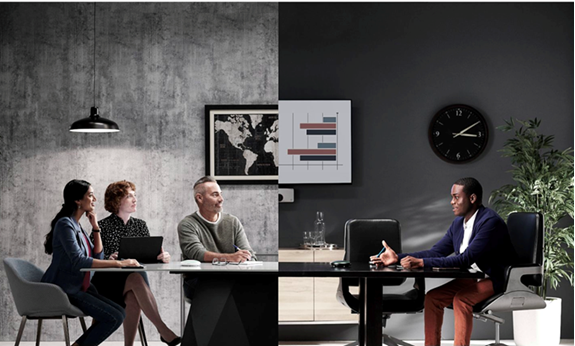CIOs contend with the challenge of hybrid work

Reconciling desktop virtualisation, productivity and employee engagement has become a headache for CIOs, but also a priority.
Analysis by Enrique Borges, Senior Market Development Manager at Shure France.

Enrique Borges, Senior Market Development Manager, Shure France
After experiencing an unprecedented acceleration since the start of the health crisis, digital transformation is proving more than ever to be a crucial issue for the future of businesses, both nationally and internationally.
The need to ensure business continuity through unpredictable cycles of office availability and remote work is challenging IT departments in every industry.
Given the constantly changing situation, where do IT Departments stand today? How are they adapting to the changes imposed by unified communication tools, and what are their priorities in the face of the new organisation of work that is taking shape?
Adjusting to the Handle the Boom in Videoconferencing
The current COVID-19 situation has exponentially accelerated the adoption of teleworking and unified communication. It was therefore necessary for CIOs to rethink their working methods in an absolute emergency. Following the first government announcements, they had to set up secure platforms, most of them without the help of their partners and integrators due to lack of availability. In the heat of the moment, CIOs have therefore focused their efforts on access to information systems, relying on unified communication solutions. Many employees found themselves having to deal overnight with the same equipment they had at their disposal before the crisis. Very quickly, in view of the intensive use of videoconferencing tools on a daily basis, they began to realize the gaps and insufficiency in terms of quality and comfort.
Although they were receptive to the hardware-related problems raised by users, IT Departments were unfortunately not able to support employees immediately due to exacting demands around setting up new infrastructure and securing network access.
"Have you ever considered the similarities between a car and a videoconferencing solution? Both have to be chosen according to how they are being used. A small city car, for example, is very practical when you don't spend a lot of time driving or traveling over long distances. If by any chance you have to make a round trip between Paris and Marseille once a month, it’s not a big deal. But let's imagine that you have to travel 1,600 kilometers every day during the week... It is this situation that many employees found themselves in, forced to deal overnight with the same videoconferencing tools and equipment they had available before the crisis. It's hard to keep going back and forth between Paris and Marseille every day in the city. In the long run it's better to opt for a nice road sedan, which provides both reliability and comfort.” - Enrique Borges, Senior Market Development Manager, Shure France.
Complexity in the Face of COVID Constraints
Very few companies have managed to realize the difficulty and complexity of rearranging meeting rooms and adapting their audiovisual equipment with COVID constraints (like rooms which are 50% occupied).
Imagining that it would be enough for them to remove one seat out of two, companies have had to grapple with the technology requirements in this approach. They then had to urgently create new rooms taking into account the requirements of social distancing. As a result, IT departments in particular were called upon to solve problems related to video, audio and, again, IT.
Growing Awareness of the Challenges of Audio
It's a fact: in videoconferencing, if you can't hear your colleagues and you can't make yourself heard, the meeting can't take place. As much as the added value of video is immediately perceptible in a remote meeting, audio is a much more complex subject to capture because it depends on the room (configuration, acoustics, layout) and its users. And although it is essential for employees in terms of quality and comfort, audio is often treated as a last priority by IT managers who are just beginning to handle the measure of these issues.
For many years, industry professionals and manufacturers have been raising awareness of the importance of audio. With the over-use of tools linked to challenges around COVID and the return of previously remote employees, many companies have become aware of the weakness of their installations. The crisis has absolutely confirmed to what extent audio quality is a priority in communication and meetings.
Certification and Technology Partners
Collaborative work has become standard in all areas. We have gone from shared documents on the cloud, to a Teams universe where, with a few exceptions, you could spend your whole working day. Collaboration software has become an essential tool in adapting to the challenge of maintaining business continuity.
Microsoft has clearly contributed to anchoring collaborative work in our daily lives with all of its customers utilising the company’s 365 platform. And, although it has already started, tomorrow we will spend even more time in virtual meetings engaging with our collaborators, along with communicating via messaging rather than email.
Microsoft has established itself with its Teams platform as the reference solution for collaborative work. CIOs, needing to improve their audio-visual installations, have discovered the importance of equipment certification to ensure reliable and simplified integration of solutions from multiple manufacturers.
Previously, the notion of inter-brand partnerships was not very present in the corporate audio-visual field, until the sector took a giant step towards the IT world. In the era of AV/IT convergence, integrators quickly found themselves talking about computer and network connections, previously not their field of expertise. Today, it is necessary for audio, and more broadly audiovisual brands, to offer solutions that are interoperable.
CIOs in Search of Autonomy
Bringing employees back to the office is the challenge for CIOs in the post-COVID world, with an appreciation that meeting rooms must be better equipped to ensure continuity between face-to-face and teleworking, and above all offer employees real added value by making their lives easier as soon as they return to the office.
To achieve this, CIOs must now, more than ever, rely on both user experience and certification. IT departments have a common objective: to have employees who are satisfied with their working conditions and commitment to, which includes good quality, well-thought-out equipment. At the same time, CIOs are also looking to gain more autonomy in the meeting rooms they manage and understand that they have the ability to find certified solutions. This is why they now expect integrators to provide them with turnkey solutions that are easy to deploy.
CIOs, who were afraid of this second wave of containment, are now asking for peace of mind, autonomy and flexibility, mastery of solutions, and the ability to upgrade a room on their own – all essential prerequisites. The next step is to be autonomous enough to be able to modify or upgrade their meeting rooms without having to systematically use an audio-visual integrator, whatever the type and size of the room.
In this uncertain economic situation, finding the right balance between telecommuting and face-to-face working is no longer a headache, but rather a quest that can only be achieved by adapting to the new expectations of employees, without sacrificing the need to ensure the security of platforms and unified communication tools used by any organisation.

Related Posts
It’s time to redefine the workplace
As the future of work continues to evolve, and the importance of communication and collaboration increases, reconfiguring collaboration spaces to build the right employee experience is now critical. IDC believes that investments to enhance hybrid meetings through audio quality can lead to tangible business outcomes.
IDC Video : Audio Issues with Hybrid Working Models
IDC Explores how quality audio can overcome the issues and consequences associated with hybrid working.